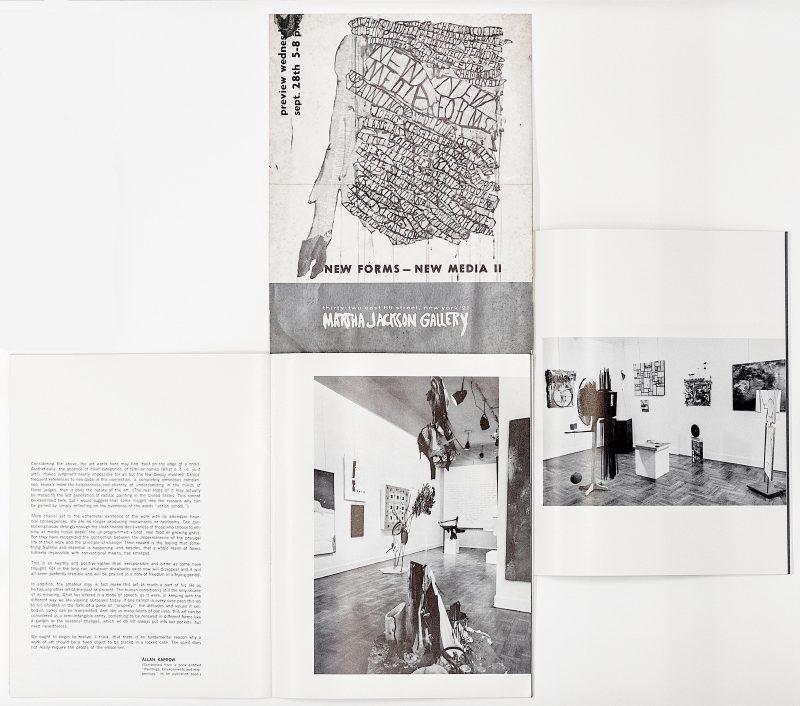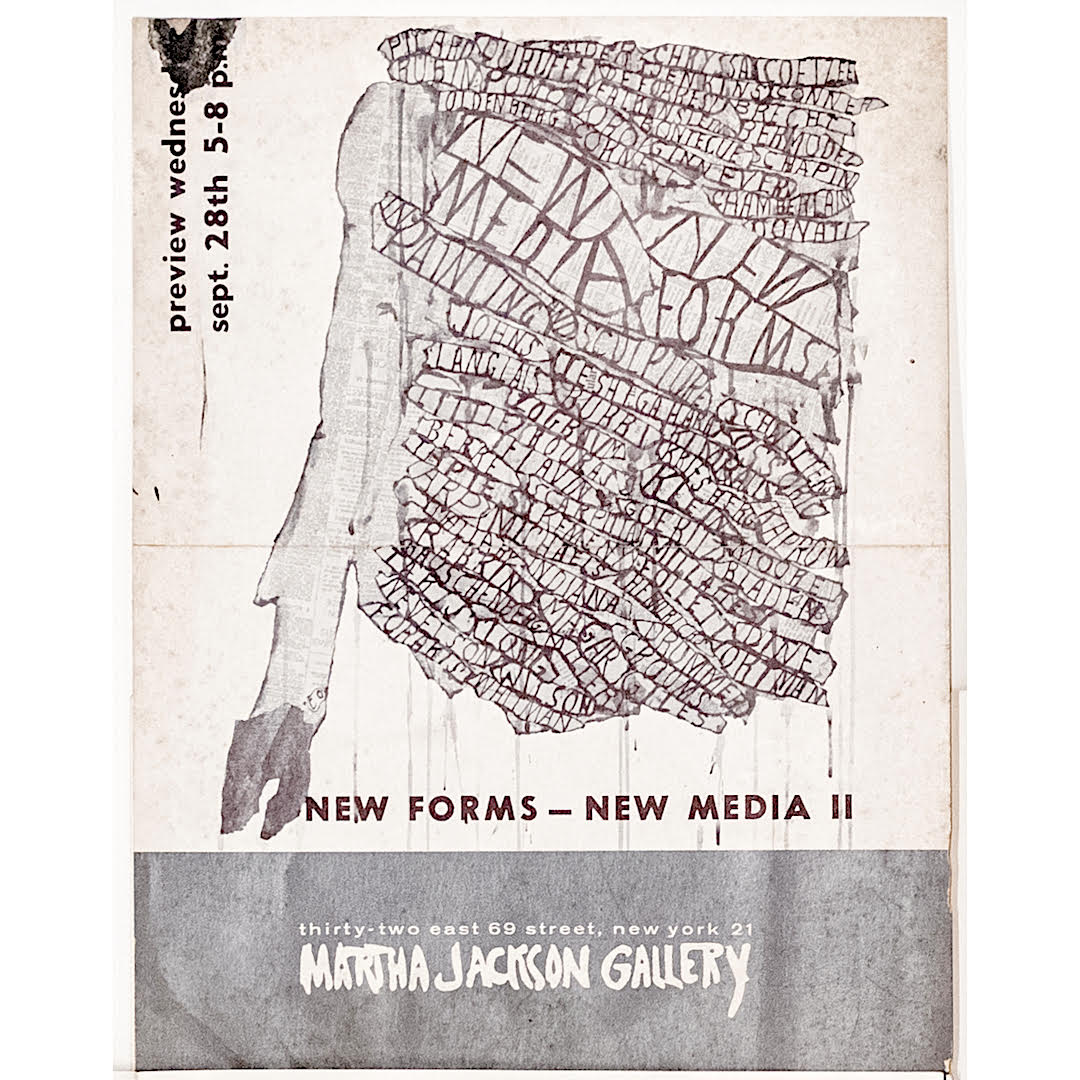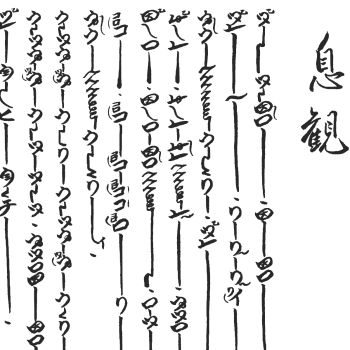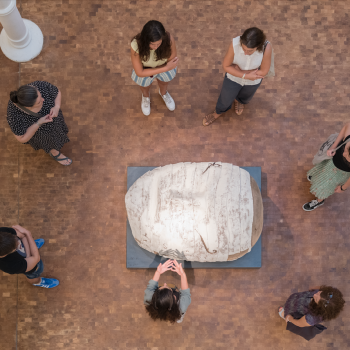Invitation to the exhibition New Forms – New Media II. Cover design: Claes Oldenburg. Martha Jackson Gallery, New
York, 28.09 –22.10.1960. Fundació Antoni Tàpies library, Barcelona.
The Martha Jackson Gallery was one of the first galleries in New York to show artists who at the end of the 1950s had begun to explore new forms of expression. In the New Forms – New Media I-II exhibitions held at the gallery in 1960, Martha Jackson, collector, art dealer and gallery owner, presented some seventy works by artists who used collage, assemblage and installation, when these practices were not yet recognised in the art world. A new term, “Junk culture”1, was coined to define artistic practices that incorporated the use of found objects and materials from the industrial, natural and everyday worlds that had been rejected by society.
Shown in two exhibitions, the first took place from 6 to 24 June, and the second, from 28 September to 22 October. Bruce Conner and Antoni Tàpies appeared in both. Conner was twenty-seven years old and Tàpies thirty-seven.
The use of new materials, of collage and assemblage, became fairly generalised among some new artists of that moment. My gallery, Martha Jackson’s, was among the first to bring together an international show on these new research avenues with two large exhibitions titled New Forms – New Media, I-II (…). 2
The exhibition catalogue New Forms – New Media I contains a foreword by Martha Jackson, the article ‘Junk Culture as a Tradition’ by curator and art critic Lawrence Alloway, and a second article, ‘Some Observations on Contemporary Art’, by the artist Allan Kaprow, whose work was also featured in both exhibitions.3 It contains some photographs of the installation taken by Rudolph Burckhardt, and includes the complete list of works in the first exhibition. Artists who were added to the second exhibition were included in a separate list. The cover design comes from a lithograph by Claes Oldenburg.

Invitation to the exhibition New Forms – New Media II and catalogue of the exhibition New Forms – New Media I. Martha Jackson Gallery, New York, 28.09 –22.10.1960. Fundació Antoni Tàpies library, Barcelona.
The Martha Jackson Gallery presented a new generation of artists who, in the late 1950s, worked with techniques such as collage and assemblage, incorporating new materials and blurring the boundaries between traditional categories of art. The failure of the historical avant-gardes – which, falling into the practice of art for art’s sake, distanced themselves from the world and from any possibility of social transformation – left open the possibility of exploring, rehearsing and redirecting artistic practices through other forms. Like other artists from their generation, Conner and Tàpies looked for alternative ways of addressing reality 4, trying to create new expressive possibilities beyond the prevailing categories. Here, Duchamp was a clear reference for many artists who in the second half of the 1950s wanted to broaden the notion of realism:5
Amid the myriad followers of abstract art and Informalist or Abstract Expressionist painting, it is not surprising that some, like myself, would again rely on “the Duchamp spirit”, and on Dada in general, to air things out, and mostly to find new pathways for a deeper insertion of art into life.6
In ‘Some observations on Contemporary Art’, the article Kaprow wrote for the New Forms – New Media I catalogue, he asked what separates a drawing from a painting, the construction of a collage or of an assemblage from a sculpture. Fragility, the mixing of techniques and materials with household objects, or elements of nature, or of waste, the rawness and immediacy, were some of the threads running through these disciplines to expose a common concern: the possibility of mutation, of change as a raison d’être. The work of art was put forward as a situation, an action, a gesture or an event. Kaprow referred to the movement expressed by these works using the term ‘extension’. Thus, the place of art extended to reality, offering the viewer the possibility of taking part in the completion of the work.7
Also exhibiting at the Martha Jackson Gallery were John Chamberlain, Joseph Cornell, Jim Dine, Jean Dubuffet, Dan Flavin, Red Grooms, Jasper Johns, Allan Kaprow, Yves Klein, Louise Nevelson, Claes Oldenburg, Robert Rauschenberg, Jean Tinguely, along with Hans Arp, Alberto Burri, Alexander Calder, Enrico Donati, Henry Moore and Kurt Schwitters – the latter six being grouped in the ‘historical section’ of the exhibition. It was a first attempt to exemplify the new forms that art was embracing, bringing them to and showing them in New York. New Forms – New Media was shown a year before the exhibition The Art of Assemblage, curated by William Seitz, was held at MoMA, New York, in late 1961. With this exhibition, MoMA – which then dominated the artistic discourse of Western art – showed and catalogued for the first time the artworks representative of this new trend. On the one hand, the exhibition tried to expand the discourse of the history of twentieth-century art by incorporating the artistic practices developed around the found object, but on the other, by continuing to categorise these artistic practices and insisting on tracing a historical continuity, it revealed the impossibility of achieving this end.8
Although today Conner is best known for his contribution to experimental cinema, throughout his artistic career he drew and painted, as well as working with assemblage, collage, sculpture and photography. From the use of found and recovered objects, and materials showing signs of degradation, Conner focused his work on looking for forms from which new values could emerge. For New Forms – New Media I, he presented Spider Lady 9, a collage-assemblage made from an old and battered wooden box containing a bicycle wheel, a window blind, photographs taken from magazines and a garter, all covered in torn nylon stockings. Working with assemblage, Conner showed his rejection of traditional notions of art as figurative, refined and permanent. In Portrait of Allen Ginsberg 10, which he presented at New Forms – New Media II, Conner completely overturned the conventions of portraiture. The materials used reflect the spirit that Beat poets, writers and artists defended and their willingly-dislocated position in the prevailing system. In the Ginsberg portrait, we do not see a face but a set of objects that tell us something about someone: a wooden platform on which rests a small metal object tied to a cord, and a wooden frame, rising vertically from the platform, sprayed with grey paint and from which hang a can and cloth bundled into nylon stockings.
Both with the matter paintings of the late 1950s and 1960s, and with the more frequent use of objects and assemblages during the 1960s, and especially from 1970 11, Tàpies developed a language that constantly evoked reality. 12. The experimentation with different materials, supports, textures, together with the use and mixture of different artistic techniques, such as collage, assemblage and printmaking, allowed him to refer to the transformative processes of formation and deformation, the changes to which both materials and objects, in common with the work of art and our own bodies, are subjected. Whether in paintings, collages, assemblages, sculptures or installations, throughout his artistic career Tàpies constantly referred to objects that came from domestic furniture: drawers, trays, chairs, mirrors, curtains, etc. These are all familiar objects that live in our memory, decidedly anti-modern and profoundly critical of consumer society. 13. If we think, for example, of the work Blanc craquelat damunt marró (Cracked White on Brown) 14, which Tàpies presented in New Forms – New Media I, we see how a form emerges from the matter that is reminiscent of a bedhead, a theme recurrent in his work: “We begin to see that the bed is both the entrance to life and often the exit, and that its most basic feature is a pillow for our heads”15
For both artists, working with objects was directly derived from the worlds of theatre and music. The admiration for figures like John Cage16 and his experiments in the field of electronic music, based on the use of repetition and chance within a certain structure, as well as the possibility of generating emotions, had a strong repercussion on both their works.
Also in the 1960s, coinciding with the success of his work with objects, Tàpies created the first ephemeral stage designs for theatrical performances: Or i Sal (1961) and Semimaru (1966) 17. He used poor materials, such as paper, cardboard, rope, clothes and objects – tables, ladders, a cane, cloth –, which were discarded once the performances were over. For Christmas 1956, he had already created an ephemeral intervention in the shop windows of the Gales clothing store on Passeig de Gràcia in Barcelona, where he installed an old metal shutter and a violin in place of the traditional nativity scene that was commonplace in Barcelona at that time.
In 1974, Conner declared in an interview: “It has to do with the theatre. Theatre in the sense of an image, an environment that’s made privately. Somebody makes an altar in their house, or they set up objects on tables, or they organize objects in windows (like a real theatre with curtains). A church is another kind of theatre; a museum, is another kind of theatre.”18
Conner’s assemblages, with nylon stockings as curtains, are another kind of theatre. Very close to Antonin Artaud’s theatre of cruelty, Conner’s assemblages willingly go beyond the framework of representation. Saturated with elements, full of images and fragmented, dirty, tortured, wrapped objects, they challenge the viewer in such a way that coming face to face with the rawness of desire, of violence, of life and death, is inescapable.19 “It has to do with the theatre’ because they are built for this purpose, to ‘make out of the theatre” – and art – “a believable reality which gives the heart and the senses that kind of concrete bite which all real sensation requires”. The bite of an altered, deranged, disoriented society.
Convinced that art had to play an active role in the political and social transformation of life, with his work Tàpies tirelessly invited the viewer to reflect, defending “Art and poetry as true magic to reveal the obfuscations of the mind and illuminate with a kind of sacred fire the smallest gestures of everyday life. The world transformed into a great temple where deities, heroes and saints can be the wind, forests and mountains, but also people and the dark corners of the humblest and most anonymous everyday life. A new world? Perhaps the oldest of the worlds, the one we have forgotten for it is sunk under the weight of cultural sedimentation, the world of the first look and the first desire… that art brings back to us”.21
1 Lawrence Alloway, ‘Junk culture as Tradition’, in New Forms – New Media I. New York: Martha Jackson Gallery, 1960.
2 Antoni Tàpies, A Personal Memoir. Fragments for an Autobiography. Bloomington, Barcelona: Indiana University Press, Fundació Antoni Tàpies, 2009: p. 331.
3 In the first exhibition, he exhibited The Oldtimer, fabric, wood and paper collage. In the second, Subway, an environment of wire, clothes and paper.
4 Núria Homs, text of the leaflet for the exhibition The Fertiliser that Feeds the Soil. Tàpies (1958-1988). Fundació Antoni Tàpies, Barcelona, 8.10.2022 – 30.06.2023.
5 See: Núria Homs, text of the leaflet for the exhibition Tàpies. Foregrounding Reality. Fundació Antoni Tàpies, Barcelona, 18.06.2021 – 20.02.2022.
6 Antoni Tàpies, A Personal Memoir. Fragments for an Autobiography. Bloomington, Barcelona: Indiana University Press, Fundació Antoni Tàpies, 2009: p. 321.
7 Allan Kaprow, ‘Some observations on Contemporary Art’, in New Forms – New Media I: New York: Martha Jackson Gallery, 1960.
8 Conner was to present two assemblages, which arrived in New York damaged. He ended up presenting an assemblage, Superhuman Devotion (1960–61), which was rejected. See: Rudolf Frieling and Gary Garrels, Bruce Conner, It’s all true. San Francisco: San Francisco Museum of Modern Art, University of California Press, 2022: p. 31.
9 Bruce Conner, Spider Lady (1959). Christian Durand-Ruel Collection, Paris.
10 Bruce Conner, Portrait of Allen Ginsberg (1960). Witney Museum of American Art, New York.
11 An example of an assemblage-object from this period could be Caixa d’embalar (1969), featured in the exhibition The Fertiliser that Feeds the Soil. Tàpies (1958–1988).
12 See: Núria Homs, text of the leaflet for the exhibition Tàpies. Foregrounding Reality. Fundació Antoni Tàpies, Barcelona, 18.06.2021 – 20.02.2022
13 Núria Homs, text of the leaflet for the exhibition Tàpies. Foregrounding Reality. Fundació Antoni Tàpies, Barcelona, 18.06.2021 – 20.02.2022.
14 Antoni Tàpies, Blanc craquelat damunt marró (Cracked White on Brown, 1959). Mixed media on canvas. 170 x 195 cm. Private collection.
15 (Trans. from) Roland Penrose, ‘Memòries nostàlgiques’, Tàpies. Barcelona: Edicions Polígrafa, 1977: p. 120.
16 ‘(…) In New York, during the early fifties, I got to know some works – and them personally – by Edgar Varèse and John Cage… All this confirmed to me the need to renew the visual language and to move away from the literary clichés of formulaic surrealism of the time and also from the geometrical orthodoxy of other groups.’ (Trans. from) Manuel J. Borja-Villel, ‘El tatuatge i el cos. Conversa amb Antoni Tàpies’, in Tàpies. El tatuatge i el cos. Papers, cartons i collages. Barcelona: Fundació Antoni Tàpies, 1998.
17 On the relationship of Tàpies with the performing arts see: Núria Homs, text of the leaflet for the exhibition Tàpies. Theatre. Fundació Antoni Tàpies, Barcelona, 25.10.2019 – 20.11.2020.
18 Kevin M. Hatch, Looking for Bruce Conner. The MIT Press, 2016: p. 59. Interview with Bruce Conner by Paul Cummings, 16.06.1973.
19 Kevin M. Hatch, op. cit.: p. 35.
20 Kevin M. Hatch, op. cit.: p. 36. Antonin Artaud. The Theatre and Its Double, first translated into English in 1958, from the original French Le Théâtre et son double (1938), a series of essays in which Artaud developed the concept of the theatre of cruelty.
21 (Trans. from) Antoni Tàpies, ‘L’art i la sociologia de l’art’, in L’art contra l’estètica. Barcelona: Ariel. Col·lecció 5 d’oros, 1974: p. 140. Article first published in La Vanguardia, 22.06.1973.














